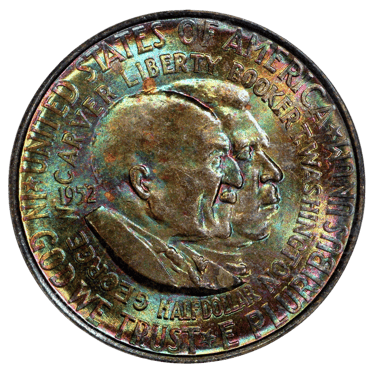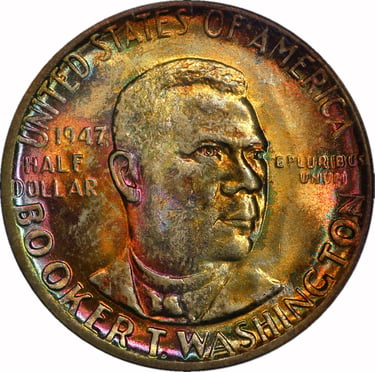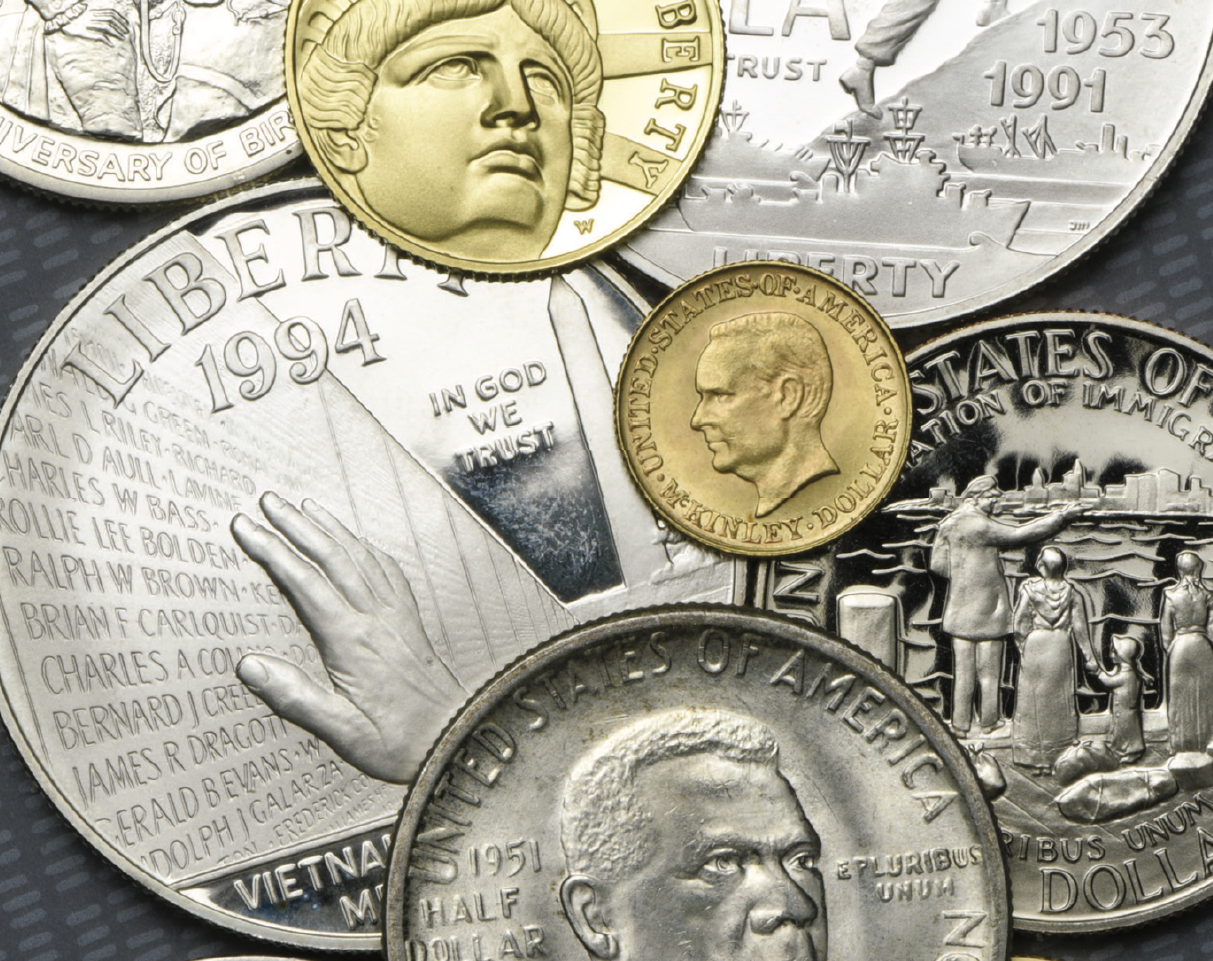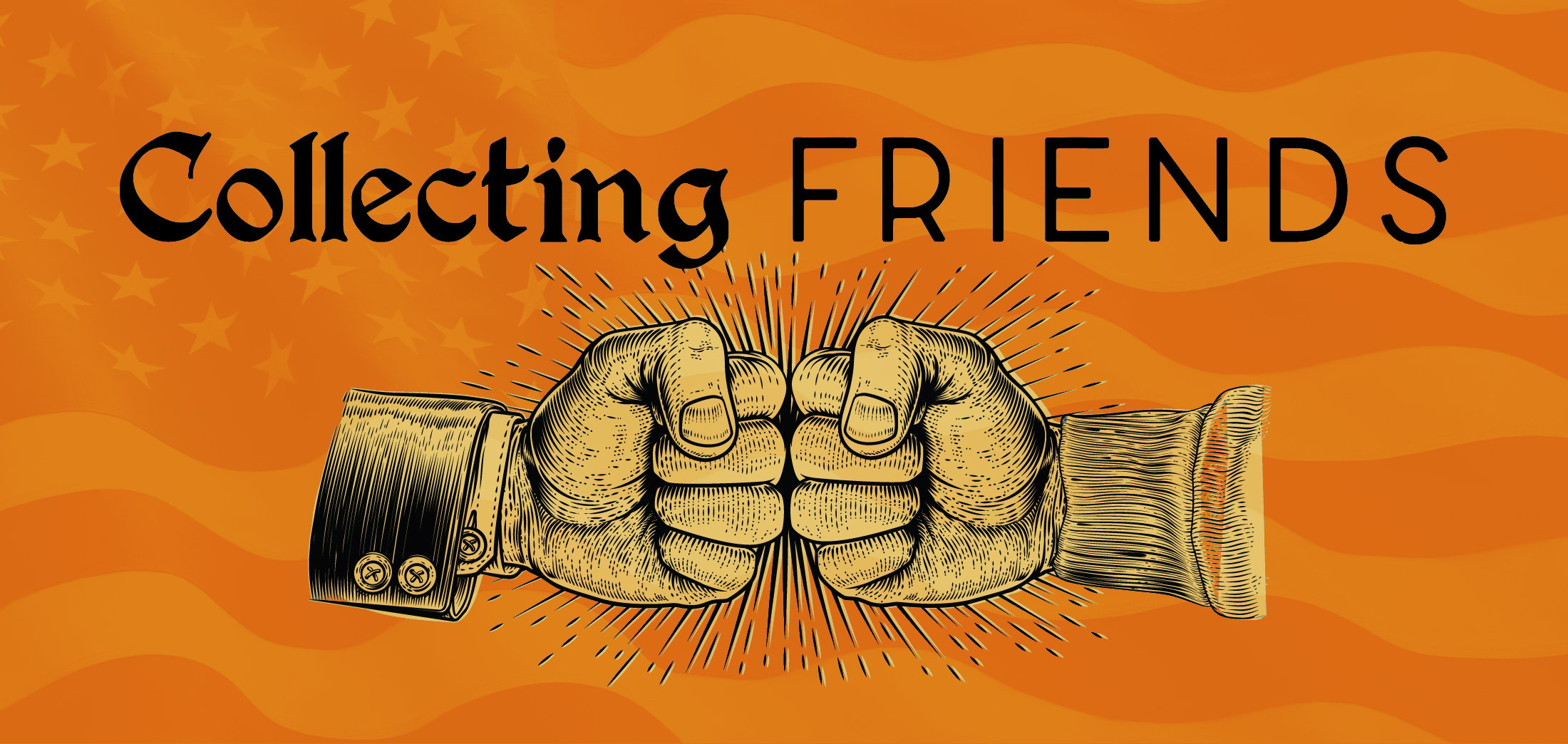Collecting Friends: What is “Americanism?”
What is "Americanism?"
Steve: In the 2016 informal survey I did for a feature at Coin World that explored attractiveness in coins, the classic commemorative series of 1892 to 1954 was often referenced, with the Washington-Carver commemorative issues of 1951 to 1954 the most frequently mentioned as lacking that quality. Designed by African American artist Isaac Scott Hathaway, the half dollar honored black educators and innovators, but its execution leaves something to be desired by even non-numismatists.  My friend Steve Bieda, himself a coin designer, said on the Washington-Carver half dollar, “the portraits are relatively well-done, but the obverse is cluttered with lettering.” Beyond aesthetics, he wondered about the Cold War slogan “Freedom and Opportunity for all — Americanism” and the lumpy map of the United States, pointing out the odd proportions of his home state Michigan. Despite the faults on both sides from a design and text perspective, he acknowledged, “At the same time, the coin has a bull dog quality about it — so ugly it’s actually a bit beautiful.”
My friend Steve Bieda, himself a coin designer, said on the Washington-Carver half dollar, “the portraits are relatively well-done, but the obverse is cluttered with lettering.” Beyond aesthetics, he wondered about the Cold War slogan “Freedom and Opportunity for all — Americanism” and the lumpy map of the United States, pointing out the odd proportions of his home state Michigan. Despite the faults on both sides from a design and text perspective, he acknowledged, “At the same time, the coin has a bull dog quality about it — so ugly it’s actually a bit beautiful.”
“A bit” is a key modifier here. The Washington-Carver half dollars honoring the lives of Booker T. Washington and George Washington Carver marked the final issue in the classic commemorative series. Anthony Swiatek wrote in his book Encyclopedia of the Commemorative Coins of the United States that the reverse design had a map that was higher than the border of the design, preventing stacking and providing poor metal flow, leading to significant work by Chief Mint Engraver Gilroy Roberts to modify the design. Swiatek points out that both Delaware and part of Maryland are omitted, making Michigan’s deficiency in form minor by comparison.
Ken Bressett, editor emeritus of A Guide Book of United States Coins (the “Red Book”) also called this half dollar his least favorite design in the series. Cornelius Vermeule, author of the 1971 book Numismatic Art in America and not one to be shy in expressing a “hot take” said that it suffered from, “too much lettering, brought about partly by the introduction of biography on the first coin and meaningless aphorisms on the second,” before calling it “impoverished of ideas and devoid of artistry.”  The goal of the half dollar was to initially help raise funds for the Booker T. Washington Birthplace Memorial in Virginia, following the Booker T. Washington commemorative half dollars issued from 1946 to 1951. That purpose was expanded by a clause in the legislation where the profits would be used to, “oppose the spread of Communism among Negroes, in the interest of the national defense.” Set within the anti-Communist fever of the era, this clause helped the bill pass and the resulting coins are odd from both a design and messaging perspective.
The goal of the half dollar was to initially help raise funds for the Booker T. Washington Birthplace Memorial in Virginia, following the Booker T. Washington commemorative half dollars issued from 1946 to 1951. That purpose was expanded by a clause in the legislation where the profits would be used to, “oppose the spread of Communism among Negroes, in the interest of the national defense.” Set within the anti-Communist fever of the era, this clause helped the bill pass and the resulting coins are odd from both a design and messaging perspective.
Dennis, what coins are a head scratcher to you?
Dennis: The U.S. commemorative coin program definitely has some doozies. It’s helpful to remember that the themes for these coins come from Congress, and not from the Mint. Congress always has its own instincts, motivations, and inspirations . . . at times hard to fathom!
For me, some of the head-scratchers include commemorative coins that commemorate commemoratives. For example, the 1991 Mount Rushmore half dollar, silver dollar, and $5 gold piece. These coins don’t directly celebrate George Washington, Thomas Jefferson, Theodore Roosevelt, and Abraham Lincoln. Instead, they celebrate a celebration of them—Gutzon Borglum’s monumental mountain-sculpture. It’s like putting the reverse of the Morgan dollar on the 2006 San Francisco Old Mint Centennial commemorative. What are we celebrating again? The mind boggles.
In 1994 there were a bunch of commemoratives that featured museums and memorials. I have mixed feelings about these. Instead of a silver dollar directly honoring Vietnam veterans, we had coins for the Vietnam Veterans Memorial. Instead of coins for American prisoners of war and women serving in the armed forces, Congress gave us silver dollars for the U.S. Prisoner of War Museum and the Women in Military Service for America Memorial. The coins feel like an indirect way of honoring their subjects.
Don’t even get me started on the 2001 commems for the U.S. Capitol Visitor Center! I don’t know what to make of the fact that collectors bought nearly twice as many of those coins as they did the 2020 Basketball Hall of Fame commemoratives.

Be on the lookout for another installment of Collecting Friends next month or subscribe here and never miss a post! In the meantime, explore beautiful coins from the ANA's Edward C. Rochette Money Museum Virtual Exhibits.
About the Collecting Friends Blog
Hello! And welcome to the ANA’s blog series, “Collecting Friends.”
We decided to approach this much like a conversation between friends. One of us starts with a topic, then the other responds. Simple as that. Along those lines, we’ll keep the tone conversational as much as possible.
We both write about coins professionally, and will keep our relative style guides in our writing. For Dennis, Publisher at Whitman Publishing, that means capitalizing “Proof” and italicizing Red Book and never saying anything bad about Ken Bressett, who’s awesome anyway.
For Steve, who’s written with Coin World for 15 years, it means Winged Liberty Head dime instead of “Mercury” dime, and similar nuances and oddities. And, it means writing A Guide Book of United States Coins (better known as the “Red Book”).
Both of us started collecting when we were little, introduced to coins by a chance encounter with an old coin that sparked our curiosity. One of Steve’s interests is coin valuation, and he gravitates towards the intersection of art and coins. Dennis enjoys medals and world coins, and studying modern U.S. coins in the context of older series, what came before.
We met in 2012 at the American Numismatic Association World’s Fair of Money in Philadelphia at an event hosted by the Austrian Mint where there was both a Ben Franklin and a Betsy Ross impersonator. We’ve become great friends in the past decade. We even were appointed together to sit on the Citizens Coinage Advisory Committee starting in 2016, but Steve resigned soon after he was appointed to accept a full-time job at the Treasury Department while Dennis was re-appointed in 2020.
We taught a course together on numismatic publishing and writing a few years ago at the Summer Seminar, and while life has gotten in the way of us teaching another class, we jumped at our friend Caleb’s suggestion that we write a column. We hope you enjoy it!
.png?width=300&height=300&name=steve%20roach%20circle%20frame%20(2).png)
.png?width=300&height=300&name=dennis%20tucker%20circle%20frame%20(2).png)
About the American Numismatic Association
The American Numismatic Association is a nonprofit organization dedicated to educating and encouraging people to study and collect coins and related items. The Association serves collectors, the general public, and academic communities with an interest in numismatics.
The ANA helps all people discover and explore the world of money through its vast array of educational programs including its museum, library, publications, conventions and numismatic seminars.

